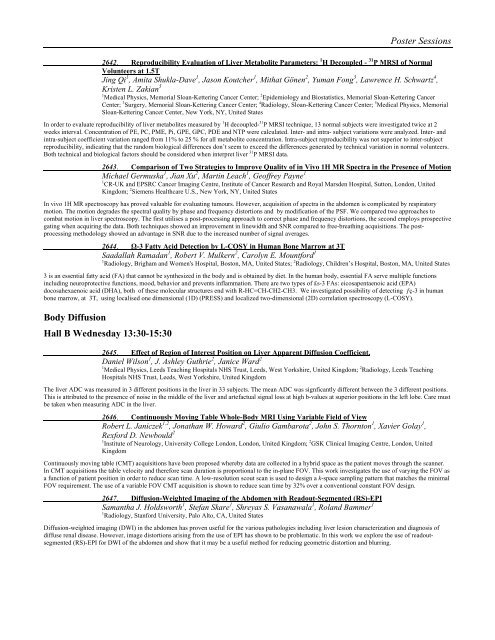TRADITIONAL POSTER - ismrm
TRADITIONAL POSTER - ismrm
TRADITIONAL POSTER - ismrm
You also want an ePaper? Increase the reach of your titles
YUMPU automatically turns print PDFs into web optimized ePapers that Google loves.
Poster Sessions<br />
2642. Reproducibility Evaluation of Liver Metabolite Parameters: 1 H Decoupled - 31 P MRSI of Normal<br />
Volunteers at 1.5T<br />
Jing Qi 1 , Amita Shukla-Dave 1 , Jason Koutcher 1 , Mithat Gönen 2 , Yuman Fong 3 , Lawrence H. Schwartz 4 ,<br />
Kristen L. Zakian 5<br />
1 Medical Physics, Memorial Sloan-Kettering Cancer Center; 2 Epidemiology and Biostatistics, Memorial Sloan-Kettering Cancer<br />
Center; 3 Surgery, Memorial Sloan-Kettering Cancer Center; 4 Radiology, Sloan-Kettering Cancer Center; 5 Medical Physics, Memorial<br />
Sloan-Kettering Cancer Center, New York, NY, United States<br />
In order to evaluate reproducibility of liver metabolites measured by 1 H decoupled- 31 P MRSI technique, 13 normal subjects were investigated twice at 2<br />
weeks interval. Concentration of PE, PC, PME, Pi, GPE, GPC, PDE and NTP were calculated. Inter- and intra- subject variations were analyzed. Inter- and<br />
intra-subject coefficient variation ranged from 11% to 25 % for all metabolite concentration. Intra-subject reproducibility was not superior to inter-subject<br />
reproducibility, indicating that the random biological differences don’t seem to exceed the differences generated by technical variation in normal volunteers.<br />
Both technical and biological factors should be considered when interpret liver 31 P MRSI data.<br />
2643. Comparison of Two Strategies to Improve Quality of in Vivo 1H MR Spectra in the Presence of Motion<br />
Michael Germuska 1 , Jian Xu 2 , Martin Leach 1 , Geoffrey Payne 1<br />
1 CR-UK and EPSRC Cancer Imaging Centre, Institute of Cancer Research and Royal Marsden Hospital, Sutton, London, United<br />
Kingdom; 2 Siemens Healthcare U.S., New York, NY, United States<br />
In vivo 1H MR spectroscopy has proved valuable for evaluating tumours. However, acquisition of spectra in the abdomen is complicated by respiratory<br />
motion. The motion degrades the spectral quality by phase and frequency distortions and by modification of the PSF. We compared two approaches to<br />
combat motion in liver spectroscopy. The first utilises a post-processing approach to correct phase and frequency distortions, the second employs prospective<br />
gating when acquiring the data. Both techniques showed an improvement in linewidth and SNR compared to free-breathing acquisitions. The postprocessing<br />
methodology showed an advantage in SNR due to the increased number of signal averages.<br />
2644. Ω-3 Fatty Acid Detection by L-COSY in Human Bone Marrow at 3T<br />
Saadallah Ramadan 1 , Robert V. Mulkern 2 , Carolyn E. Mountford 1<br />
1 Radiology, Brigham and Women's Hospital, Boston, MA, United States; 2 Radiology, Children’s Hospital, Boston, MA, United States<br />
3 is an essential fatty acid (FA) that cannot be synthesized in the body and is obtained by diet. In the human body, essential FA serve multiple functions<br />
including neuroprotective functions, mood, behavior and prevents inflammation. There are two types of £s-3 FAs: eicosapentaenoic acid (EPA)<br />
docosahexaenoic acid (DHA), both of these molecular structures end with R-HC=CH-CH2-CH3. We investigated possibility of detecting č-3 in human<br />
bone marrow, at 3T, using localised one dimensional (1D) (PRESS) and localized two-dimensional (2D) correlation spectroscopy (L-COSY).<br />
Body Diffusion<br />
Hall B Wednesday 13:30-15:30<br />
2645. Effect of Region of Interest Position on Liver Apparent Diffusion Coefficient.<br />
Daniel Wilson 1 , J. Ashley Guthrie 2 , Janice Ward 2<br />
1 Medical Physics, Leeds Teaching Hospitals NHS Trust, Leeds, West Yorkshire, United Kingdom; 2 Radiology, Leeds Teaching<br />
Hospitals NHS Trust, Leeds, West Yorkshire, United Kingdom<br />
The liver ADC was measured in 3 different positions in the liver in 33 subjects. The mean ADC was signficantly different between the 3 different positions.<br />
This is attributed to the presence of noise in the middle of the liver and artefactual signal loss at high b-values at superior positions in the left lobe. Care must<br />
be taken when measuring ADC in the liver.<br />
2646. Continuously Moving Table Whole-Body MRI Using Variable Field of View<br />
Robert L. Janiczek 1,2 , Jonathan W. Howard 2 , Giulio Gambarota 2 , John S. Thornton 1 , Xavier Golay 1 ,<br />
Rexford D. Newbould 2<br />
1 Institute of Neurology, University College London, London, United Kingdom; 2 GSK Clinical Imaging Centre, London, United<br />
Kingdom<br />
Continuously moving table (CMT) acquisitions have been proposed whereby data are collected in a hybrid space as the patient moves through the scanner.<br />
In CMT acquisitions the table velocity and therefore scan duration is proportional to the in-plane FOV. This work investigates the use of varying the FOV as<br />
a function of patient position in order to reduce scan time. A low-resolution scout scan is used to design a k-space sampling pattern that matches the minimal<br />
FOV requirement. The use of a variable FOV CMT acquisition is shown to reduce scan time by 32% over a conventional constant FOV design.<br />
2647. Diffusion-Weighted Imaging of the Abdomen with Readout-Segmented (RS)-EPI<br />
Samantha J. Holdsworth 1 , Stefan Skare 1 , Shreyas S. Vasanawala 1 , Roland Bammer 1<br />
1 Radiology, Stanford University, Palo Alto, CA, United States<br />
Diffusion-weighted imaging (DWI) in the abdomen has proven useful for the various pathologies including liver lesion characterization and diagnosis of<br />
diffuse renal disease. However, image distortions arising from the use of EPI has shown to be problematic. In this work we explore the use of readoutsegmented<br />
(RS)-EPI for DWI of the abdomen and show that it may be a useful method for reducing geometric distortion and blurring.















